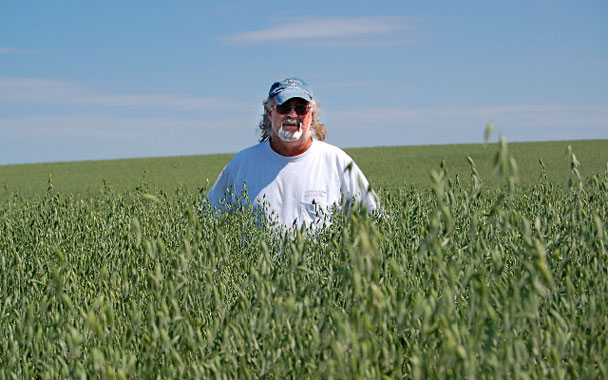Charlie Johnson, Lake County, South Dakota
It is asserted as if it is natural law: Organic farming is impossible on the Great Plains. It is an absolute truth embraced by huge industrial farmers who have spent half a century embracing the trinity of genetically modified seeds, chemical fertilizers and pesticides, and ever more powerful, ever more expensive, tractors and other equipment. It is embraced just as vigorously by small-acre organic farmers who cannot imagine that the complex details of soil and farm ecology required for organic farming can be managed on the huge scale of the Plains. So what are Charlie and Allan Johnson doing operating a 2,400-acre organic family farm in South Dakota? They’re making almost twice the profit on their crops that their conventional neighbors are making … that’s what.
“My father was a hippie, but he had a crew cut” Charlie says, to describe Bernie Johnson. “If 100 people came to a fork in the road, and 99 went in one direction, Bernie would go in the other. Dad used to say, ‘If I can’t put it on my tongue, I’m not going to put it on my crops.’” Bernie Johnson and his brother went totally organic in 1976. That was back when there was no premium for organic crops, when being organic was a cause. The family never looked back.
The Johnson family home is a neatly mowed compound of grain silos, chicken coops, a classic red barn, and a weathered white house. An American flag stands guard, and fields of soybeans, corn, and oats stretch to the horizon. When I arrive, Charlie’s wife Bette is shoulder deep in the drainage ditch beside the driveway, hand-cutting Canadian thistle weeds before they go to seed. “It’s hand-to-hand combat,” Charlie says, laughing. “Last week was the biggest week of cultivating [disking the soil for weed control] I’ve done in my life. I was in the tractor from eight A.M. to midnight. Six hundred acres in eight days.”
Like every South Dakota farmer east of the Missouri River, the Johnsons have been fighting Mother Nature since early June, when a massive storm dumped two and a half inches of rain on the land in a half hour. “We had too much rain, too fast, on too wet a ground. It gave the weeds a head start.” Conventional farmers can spray 1,000 acres in a few hours. But to keep their organic certification, the Johnsons must accomplish the same tasks without chemicals. Charlie is philosophical. “Mother Nature and God gave us 100 percent of what we have. If she needs to take back 10 percent for insects and floods, that’s okay.”
The economic key to the Johnson philosophy is that human labor replaces high-tech inputs. But it is a Sisyphean task. In a few weeks, Charlie and his brother, with their families and teenagers from town, will be in the fields weeding with hand machetes. But even so, they can’t keep up, especially in a year like this. Charlie has hired a crew of a dozen Hispanic farm workers to cut weeds. They will arrive in the next few days. “They are grown men. They’ll work all day. The kids from town and the family start at eight and we’re beat by noon.”
The Johnsons’ 2,400 acres seems large, but on the scale of Great Plains farming, it is a middle-sized farm that is surrounded by the massive fields of an absentee industrial farmer, who operates 50,000 acres of commodity grains. While their neighbor thinks big, the Johnsons think small, work small. They have divided their cropland into 45 fields, some as large as 60 acres, some as small as 7. Their six-year crop rotation is complicated: It cycles from alfalfa hay to soybeans to corn to rye (as a green manure), to oats, and back to alfalfa, each with its own ecological purpose and economic value. Charlie is quick to point out that even with the late start and the weeds, Johnson corn is just as tall and healthy as the neighbor’s, but he is particularly proud of this year’s field of oats, which is chest high and almost ready for harvest. I ask if there is anything that could threaten the oats. “A hailstorm.” He looks out over the whole farm. “There is about $500,000 in crops out there. Hail could wipe out half that value in a half hour.”
In the past, much of the harvest was fed to the farm’s organic cattle. But in the last few years the value of organic crops has risen so quickly that Charlie now sells them on the open market. “I could have sold my corn crop five times over last year.” His entire 2008 crop is already under contract. He is closemouthed about his prices, but the USDA reports this week that organic soybeans are selling for around $28 a bushel and corn is selling for nearly $11, almost double the price conventional farmers are being paid.
Organic farming begins as a way of life—and it is not for the faint of heart—but in the current market, there are big profits to be made. That is, of course, if it doesn’t hail, and if the farm isn’t hit by a tornado, and if the family can stay ahead in the endless war against weeds.


